Speak AAC

The more we use AAC, the more our beginning communicators will use it, too.
Filed under: Uncategorized
Tagged With: aided language input

The more we use AAC, the more our beginning communicators will use it, too.
Filed under: Uncategorized
Tagged With: aided language input

Work with learners who have difficulty processing language and are just learning to use their AAC systems? Dr. Jill Senner has a strategy for you! Thanks to DynaVox for hosting this terrific presentation. Direct link to video: http://www.dynavoxtech.com/training/toolkit/details.aspx?id=261
Filed under: Video of the Week
Tagged With: aided language input, augmented input, Jill Senner
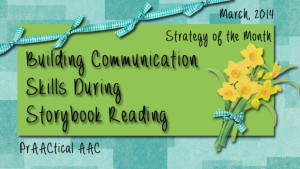
In this post, we continue to explore strategies for advancing the literacy experiences of people who use AAC. Today, we’ll look at a strategy used in the research of Drs. Cathy Binger and Jennifer Kent-Walsh. What is a little different about this strategy is that it uses literacy experiences, specifically storybook reading, to build communication skills. One component of their research focuses on an interactive reading strategy called RAAP: Read, Ask, Answer, Prompt. There is lots to love about this approach, but one of our favorite things is that is makes heavy use of aided language input, an intervention strategy that is critical for partners of beginning communicators to use. You can read more about aided language input and see videos here. It also gets partners using language expansions and extensions, an intervention strategy that is effective for communicators at many levels of proficiency. Finally, we appreciate the frequent use of... [Read More...]
Filed under: PrAACtical Thinking
Tagged With: aided language input, Cathy Binger, expansion, extensions, Jennifer Kent-Walsh, literacy, pause, RAA, RAAP, reading
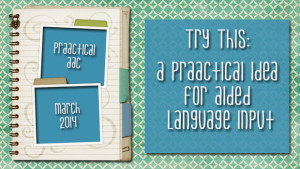
At the ATIA 2014 conference in January, it was exciting to hear about the updates on how core vocabulary is being addressed in the alternate assessment project for Dynamic Learning Maps. Allison Dennis, Dr. Karen Erickson, and Dr. Penny Hatch, of the Center for Literacy and Disability Studies, shared a lot of interesting information, as you can see from their handout. One of my favorite ‘take-aways,’ though, was a suggestion by Karen Erickson regarding the importance of aided language input for students with significant disabilities. We’ve written about aided language input so often that you may be tired of hearing it, but bear with us because her suggestion was pure genius. Ready? Here it is: List aided language input as an accommodation in the IEP. Why List Aided Language Input as an IEP Accommodation? It is a fundamental strategy for any beginning learner of AAC. It is rarely implemented... [Read More...]
Filed under: PrAACtical Thinking
Tagged With: aided language input, ATIA 2014, Karen Erickson
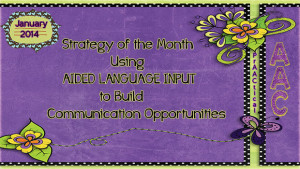
We can not write, speak or do enough Aided Language Input (ALI). If we expect learners to speak AAC, we must speak AAC to them. It is difficult enough to learn a language and imagine if no one spoke it to you in the language you were expected to speak…But there are so many more reasons to do ALI. Aided Language Input (ALI) belongs in the context of communication opportunities. It is modeling AAC style. Once we model a target language concept AAC style, then add the wait and signal strategy, the learner then knows it is their communicative turn. Especially if you wait with the raised eye brow signal. They often will take their turn expressively. But, if they do not take the communicative opportunity to take their turn, there are gestural, visual, verbal, and physical prompts that can be implemented. In other words, they can make use of... [Read More...]
Filed under: Strategy of the Month
Tagged With: aided language input, ALI, communication opportunities
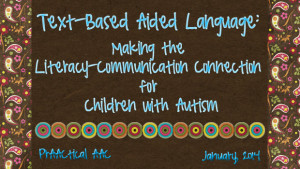
We are so pleased to have this guest post by Alicia Garcia. She is the lead SLP at AAC Clinic at One Kids Place, in Ontario. You can read her previous post here. Today, Alicia takes us in a textual direction. Enjoy! When working with children with autism who have complex communication needs we have found it is not uncommon to see children who, despite having significant communication and language challenges, can read and sometimes type words. Their ability to decode written words is far superior to their ability to communicate their wants, needs and thoughts. Some of these children use AAC systems for their face-to-face communication and, in some cases, have a literacy program in place; they frequently have handy access to writing or typing tools. These children do not, however, use text to communicate with people. They have not made the Literacy-Communication connection. We wonder… how do we help these... [Read More...]
Filed under: PrAACtical Thinking
Tagged With: aided language input, Alicia Garcia, literacy

It’s been a wonderfully prAACtical year. Here’s a look back at our top 10 most popular posts. Anyone see any patterns? 🙂 How I Do It: Writing IEP Goals for Students Who Use AAC by Lauren Enders Teaching Core Vocabulary 5 Great Resources for Pre-Made Communication Boards Core Samples A Year Of Core Vocabulary Words AAC ‘Must Haves’ the the Classroom and Therapy Room Pivotal Skills for AAC Intervention: Aided Language Input How I Do It: AAC in the IEP by Lauren Enders Getting Started with Core Vocabulary More on Teaching Core Vocabulary
Filed under: PrAACtical Thinking
Tagged With: aided language input, communication boards, core vocabulary, IEP, Lauren Enders
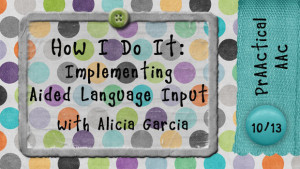
We are so pleased to have reconnected with SLP Alicia Garcia and are even more delighted that she agreed to do a guest post. Alicia is the clinical lead of the AAC Clinic at One Kids Place, a children’s treatment centre in northern Ontario. She has over 20 years of experience in pediatric rehabilitation practice in private and public settings, including clinical practice in AAC clinics and programs in Wisconsin, Florida, and now in Ontario. In this post, Alicia addresses one of our favorite clinical strategies in a very prAACtical way. Implementing Aided Language Stimulation: 8 Frequent Mistakes and How to Avoid Them Aided Language seems like a simple concept: Partners should model or demonstrate picture communication when talking to children who are learning to use picture communication, so that they would learn by example. Yet, when it comes to implementation we see frequent mistakes and misinterpretations. The most commons being:... [Read More...]
Filed under: PrAACtical Thinking
Tagged With: aided language input, Alicia Garcia, How I Do It
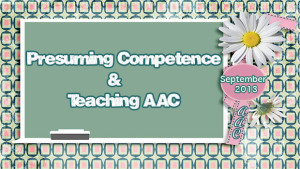
We have said this before, we say it now, and we will say it again because time and time again we are surprised in great ways. Aided Language Input Talk About Relevant Topics Talk About Age-Appropriate Topics Use Language Facilitation Techniques And….Listen to the Message, Be a Communication Partner, Have Fun!
Filed under: PrAACtical Thinking
Tagged With: aided language input, Language facilitation strategies, presume competence
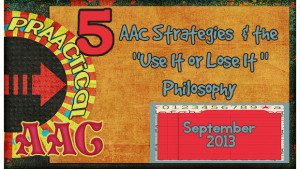
School has begun for almost everyone. Some classes have been in session for a while and routines have been formed, learning is taking place, behaviors have settled down. Now comes what can seem like the hard part: Keeping up with and expanding the strategies that helped students become successful. Instead of trying to fade AAC displays/devices and visual supports, stick with the basics and expand how they can be used. Because if you don’t use it, you may lose it. So: Keep up with: Visual Schedules– monthly, daily, and mini. Even if students know the schedule, continue to use it. Most of us would not like ‘losing’ our day planner or ‘to do’ lists even though we know our schedules. Aided Language Input First- Then Visual Support Visual Boundaries Access to a AAC Display/Device– And the display or device is with the student All the time, everywhere, charged, working, and... [Read More...]
Filed under: PrAACtical Thinking
Tagged With: aided language input, resources, visual schedules, visual supports